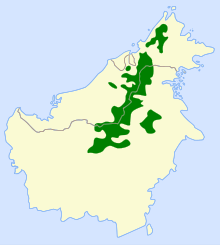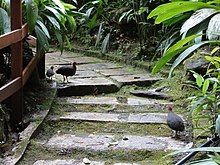Crimson-headed partridge
| Crimson-headed partridge | |
|---|---|

| |
| Male | |
| Scientific classification | |
| Domain: | Eukaryota |
| Kingdom: | Animalia |
| Phylum: | Chordata |
| Class: | Aves |
| Order: | Galliformes |
| Family: | Phasianidae |
| Subfamily: | Phasianinae |
| Genus: | Haematortyx Sharpe, 1879 |
| Species: | H. sanguiniceps
|
| Binomial name | |
| Haematortyx sanguiniceps Sharpe, 1879
| |

| |
Range
| |
The crimson-headed partridge (Haematortyx sanguiniceps) is a
The species feeds on berries, insects, and small
Taxonomy and systematics
In 1879, the British ornithologist Richard Bowdler Sharpe described the crimson-headed partridge as Haematortyx sanguiniceps on the basis of specimens from the Lawa River. It is the type species of the genus Haematortyx, which was created for it.[2] The name of the genus is from the Ancient Greek haima, meaning "blood", and ortux, meaning "quail". The specific name sanguiniceps comes from the Modern Latin sanguis or sanguinis, meaning "blood", and -ceps, meaning "-headed".[3] "Crimson-headed partridge" has been designated the official common name by the International Ornithologists' Union.[4] It is also known as the crimson-headed wood partridge.[5] It has no recognised subspecies.[4]
The crimson-headed partridge is the
Description

A striking species of partridge, the crimson-headed partridge has an average length of around 25 cm (9.8 in) and the weight of one measured male was 330 g (12 oz). Adult males have a distinctive appearance; the heads, necks, and breasts, along with the final section of the undertail coverts, are crimson red, while the rest of the body is dark blackish. The bill is yellow to yellowish white, the iris is brown with a yellow orbital ring, and the feet are grey with one to three tarsal spurs. Adult females have a similar pattern, bur differ in their duller and browner plumage, more orangish red on the head and breast, brownish-black bill, and lack of spurs. Juveniles are duller and have the crimson restricted to the top of the head, with a brownish orange head, rust-red markings on a blackish-brown breast, and red tips to the wing coverts.[5][8][9]
The species is unlikely to be confused with any other, with its colouration only resembling that of an immature male black partridge (Melanoperdix niger). It can be told apart from the latter by the black partridge's broader black bill.[5]
Vocalisations
The crimson-headed partridge's song is harsh, loud, repeated call rendered as KRO-krang, kong-krrang, or whu-kweng. It is frequently given alternately by two individuals. A grating, clucking kak-kak-kak, ok-ak-ok, krak-krak or whu-keng-keng-keng-kok-kok is also made when excited.[5][8][9]
Distribution and habitat
The crimson-headed partridge is
Behaviour and ecology

The species'
Nesting occurs in kerangas forests, with nests of dry leaves being built in tussocks of grass or lichen. Egg laying has been reported from mid-January onwards, with breeding males reported in March and young in April. Clutches have 8–9 light brown eggs with dark yellowish-brown streaking. Incubation takes 18–19 days in captivity.[5][8]
Status
The crimson-headed partridge is classified as being of least concern by the International Union for Conservation of Nature due to its fairly large range, sufficiently large population, and a lack of significant population decline. It was previously considered near-threatened and is thought to have a population of 1,000–10,000 total individuals, with 670–6,700 mature birds. It is locally common, but has a highly reduced range, with a declining population. There are no recent records of the species from central Kalimantan and its status there is unknown. It occurs in some protected areas like Kinabalu Park and Gunung Mulu National Park.[1][5][8]
References
- ^ . Retrieved 2021-11-13.
- OCLC 1377260 – via Biodiversity Heritage Library.
- OCLC 1040808348.
- ^ a b c Gill, Frank; Donsker, David; Rasmussen, Pamela (eds.). "Pheasants, partridges, francolins – IOC World Bird List". Retrieved 2022-03-27.
- ^ OCLC 1274669309.
- S2CID 216315583. Retrieved 2022-03-27.
- S2CID 231963063.
- ^ S2CID 241910588. Retrieved 2022-03-29.
- ^ OCLC 944318084.
External links
 Media related to Haematortyx sanguiniceps at Wikimedia Commons
Media related to Haematortyx sanguiniceps at Wikimedia Commons Data related to Haematortyx sanguiniceps at Wikispecies
Data related to Haematortyx sanguiniceps at Wikispecies

